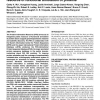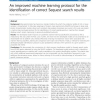411 search results - page 9 / 83 » Using context to improve protein domain identification |
IMSCCS
2006
IEEE
15 years 5 months ago
2006
IEEE
Background: Hydrophobins are fungal proteins that can turn into amphipathic membranes at hydrophilic/hydrophobic interfaces by self-assembly. The assemblages by Class I hydrophobi...
105
click to vote
NAR
2002
2002
The Protein Information Resource: an integrated public resource of functional annotation of proteins
14 years 11 months ago
The Protein Information Resource (PIR) serves as an integrated public resource of functional annotation of protein data to support genomic/proteomic research and scientific discov...
87
Voted
BMCBI
2008
14 years 12 months ago
2008
Background: Transcription factors (TFs) are core functional proteins which play important roles in gene expression control, and they are key factors for gene regulation network co...
130
click to vote
BMCBI
2010
14 years 9 months ago
2010
Background: Mass spectrometry has become a standard method by which the proteomic profile of cell or tissue samples is characterized. To fully take advantage of tandem mass spectr...
90
Voted
BMCBI
2010
14 years 12 months ago
2010
Background: Efficient dissection of large proteins into their structural domains is critical for high throughput proteome analysis. So far, no study has focused on mathematically ...


